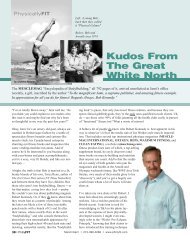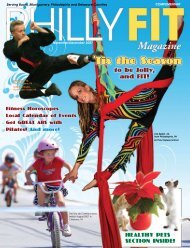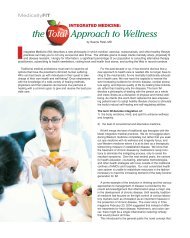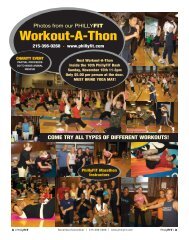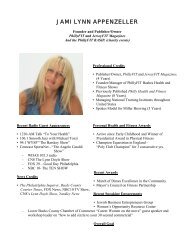cover 0708.qxd - PhillyFIT Magazine
cover 0708.qxd - PhillyFIT Magazine
cover 0708.qxd - PhillyFIT Magazine
You also want an ePaper? Increase the reach of your titles
YUMPU automatically turns print PDFs into web optimized ePapers that Google loves.
PhysicallyFIT<br />
The Best<br />
Time Spent<br />
How Coaches and Athletes Can Most<br />
Benefit from an Hour at the Track<br />
By: Todd Parker, M.A., M.S.<br />
Many athletes and coaches head to the track for speed<br />
work; however, for triathletes and distance runners, there<br />
is a more important workout known as a pacing session.<br />
The moment the runner and I step on the track, I assess<br />
biomechanics and form. Pacing for distance runs and<br />
triathlons is one of the most critical components of successful<br />
racing, and yet most never spend a concerted<br />
effort “dialing it in.”<br />
Todd<br />
Parker<br />
Why is that Unfortunately, most athletes are glued to their Heart Rate<br />
Monitor (HRM) devices and use this feedback as the primary means to<br />
pacing their runs. However it is just as critical to “learn the body<br />
through the mind,” and use your personal biofeedback techniques to stay<br />
within an intensity level appropriate to the race distance, course, and conditions.<br />
By raising awareness of and learning your Perceived Exertion<br />
(PE), as well as your onset and sweat rates for various conditions and<br />
hydration, levels and how they alter within the eight training zones (but<br />
especially Sub-Lactate Threshold through VO2max), the athlete can dialin<br />
the optimal sustainable pacing.<br />
You must remember, however, that when relying on HR as a performance<br />
indicator, many things affect that HR. In most cases, HR is elevated by<br />
inadequate re<strong>cover</strong>y, hydration, or glycogen storage levels, as well as<br />
overall physical, psychological, and emotional stress load, ambient temperature,<br />
humidity, wind, altitude, terrain, and caffeine.<br />
When I am with an athlete at the track, I prefer that they not focus on<br />
their HR, and only refer to it at specific times. By having them focus on<br />
PE, they can learn to gauge pacing more reliably. This is an important<br />
skill to learn across the spectrum of conditions and intensities. Once<br />
learned, it makes sustainable pacing performance much easier to identify<br />
– whether you use a HRM or not. The pacing session I often do with my<br />
athletes at the track for the first time is as follows:<br />
24 I <strong>PhillyFIT</strong><br />
March/April I 215-396-0268 I www.phillyfit.com




